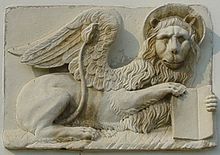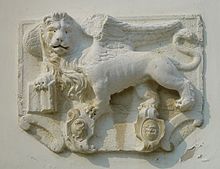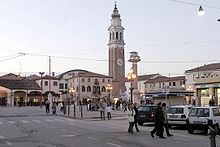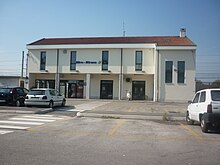Mirano
| Mirano | ||
|---|---|---|

|
|
|
| Country | Italy | |
| region | Veneto | |
| Metropolitan city | Venice (VE) | |
| Local name | Miràn | |
| Coordinates | 45 ° 30 ′ N , 12 ° 6 ′ E | |
| height | 9 m slm | |
| surface | 45.62 km² | |
| Residents | 27,371 (Dec. 31, 2019) | |
| Population density | 600 inhabitants / km² | |
| Post Code | 30035 | |
| prefix | 041 | |
| ISTAT number | 027024 | |
| Popular name | Miranesi | |
| Patron saint | San Matteo | |
| Website | Mirano | |
Mirano , in the Venetian town of Miràn , is a municipality with 27,371 inhabitants (as of December 31, 2019) in the metropolitan city of Venice in the Veneto region in Italy .
The place covers an area of 45.62 km². The neighboring communities are Salzano , Dolo , Mira , Pianiga , Spinea and Santa Maria di Sala .
The municipality has six districts: Vetrego , Scaltenigo, Ballò, Campocroce di Mirano, Zianigo and Mirano capoluogo. A station for regional trains on the Milan – Venice line connects the city with the surrounding cities.
history
After 568 the Lombards occupied Mirano, which probably had Roman roots, and the Collalto received the settlement and its surrounding area. In 972 Otto I awarded some goods in the Miranese to the diocese of Freising , but in 1008 the Bishop of Treviso received the goods in the Miranese. In 1117 Abbot Peter bought some goods for the Abbey of Sant'Ilario in Venice from the Conti of the Marca Trevigiana, Arsedisio and Vidotto di Collalto.
In a bull by Pope Eugen III. the Church of San Michele and the Church of Zianigo are mentioned for the first time. At this time Mirano came increasingly under the influence of Padua and thus in its conflicts with Treviso (1229). From 1237 to 1256 Mirano was under Ezzelino da Romano . In 1272 the community was again under Padua, which had a fortification built with 300 infantrymen and 200 mounted men.
But as early as 1256, Bolzonella, Pietro da Peraga's only daughter, brought various goods, including the castle, into the marriage with the Venetian Marino Badoer . The Badoer da Peraga family also dominated the small town during the rule of Padua. The tower of Zianigo, which was converted into a bell tower and bears the coat of arms of Carrara, the Signori of Verona, dates from this period. During the war between Cangrande I della Scala and Padua, the former had the castle of Mirano destroyed, but in 1325, six years after the destruction, the city returned to the possession of Filippo da Peraga. Between 1331 and 1337 the Venetians temporarily occupied the rebuilt castle.
Venice finally occupied the city in 1403. In 1405 Padua was conquered.
On September 6, 1477, the Senate ordered the establishment of a Monday market and a fair, the Fiera di San Matteo . The latter should take place annually from September 21 to 23. In 1509 Mirano was destroyed by troops of the League of Cambrai . For his services to the reconquest of Padua, the Miranese Alvise Dardani was raised to Cancelliere Grando , Grand Chancellor. It was the highest dignity that a non-noble person could achieve in Venice.
In 1612, the excavation work on Taglio Nuovo , also called Canale di Mirano , with which the water from the Bacino inferiore di Mirano of the Muson Vecchio river was to be diverted to Mira on the Riviera del Brenta , was completed. The Taglio enabled a ship connection between Venice and Padua. With the Canale Taglio Nuovissimo , the system of navigable canals was extended to Chioggia .
In 1766 there were 5161 inhabitants from 1036 families, of whom 497 lived in Mirano capoluogo, 125 in Campocroce, 129 in Scaltenigo, 62 each in Vetrego and Ballò and 181 in Zianigo. In the 17th and 18th centuries, around 30 villas were built around the town.
In 1797 Napoleon's French troops occupied Venice and with it Mirano. All symbols of the Republic of Venice should be removed. The lion of San Marco from the 15th century, which was restored in 1617, was also destroyed. Mirano became the seat of a canton in the Camposampiero district, which in turn became part of the Padoue department . With the withdrawal of the French in 1814, the Comune became the capital of the district of the same name in the new province of Padua. The new district, which existed until 1852, now included Salzano , Noale and Scorzè . A Regio Commissariato di Polizia and a Pretura were also set up. The railway bridge from 1842 cut off the frazione Vetrego . From 1853 the district of Mirano was attached to the province of Venice .
Until the end of the 19th century, Mirano lay on an island, which was surrounded by a smaller arm of the Muson (today Via Castelantico), and was closed in the south by the park of Villa Errera, as was the Bacino di sotto. In order to enable the construction of the railway bridge, the said arm was piped and today's large central square was created, which was named Piazza Vittorio Emanuele II . In 1903 a reconstruction of the lion column was erected on this square, which the sculptor Urbano Bottazzo had created. In 1933 the Venice-Padua highway was inaugurated, separating the municipality from another frazione , Vetrego .
In Mirano, Filippo Grimani , mayor of Venice from 1895 to 1919, acquired the property of the Boldù family and in 1880 an 18th century villa. On October 26, 1886 he was elected mayor of Mirano and in 1889 he represented the place in the provincial assembly.
Paolo Errera was Mayor of Mirano from 1895 to 1920. In 1892 he married Nella Grassini, with whom he had three sons. When Amedeo died of tetanus at the age of 15 , the parents established a foundation that still exists today. The couple were arrested on February 25, 1944 and interned in Santa Maria Maggiore prison in Venice. It was then deported to the Fossoli transit camp, deported to Auschwitz on April 5, 1944, and murdered there five days later. Since 2007 the former Piazza delle Erbe in Mirano has been called Piazza Paolo e Nella Errera .
Between July 25, 1943 and April 27, 1945, 15 partisans died in Mirano. After them, the Piazza Vittorio Emanuele II was renamed Piazza Martiri per la libertà .
In 1966 the historical center was placed under protection, in 1969 the municipality acquired the park and the Villa Belvedere in the new protected area. In 1975, Mirano acquired the Villa Morosini and its park (today XXV April ) and erected a monument to commemorate the partisans. In 2002 Mirano was also formally recognized as a city.
Until 2003, the Mira-Mirano station existed on the Milan – Venice line .
Personalities
- Giovanni Battista Tiepolo , also called Giambattista Tiepolo, (1696–1770), Venetian painter
- Giovanni Domenico Tiepolo , (1727–1804), Venetian painter
- Paolo Errera (1861–1944) Mayor of Mirano from 1895 to 1920, murdered together with his wife in Auschwitz
- Josefine Bakhita (1869–1947), Roman Catholic saint
- Mario Vallotto (1933–1966), track cyclist and Olympic champion
- Erika Zanetti (* 1985), inline speed skater
- Federica Pellegrini (* 1988), swimmer and Olympic champion
- Francesco Lamon (* 1994), cyclist
literature
- Antonio Stangherlin: Ville venete nel comune di Mirano. Nel cinquantenario della vittoria , Mirano 1970.
- Marina Stefani Mantovanelli: Le ville ei parchi comunali di Mirano. Itinerari storico-artistici, Mirano 2000.
Web links
- Storia , the story of Mirano on the municipality's website
Individual evidence
- ↑ Statistiche demografiche ISTAT. Monthly population statistics of the Istituto Nazionale di Statistica , as of December 31 of 2019.






